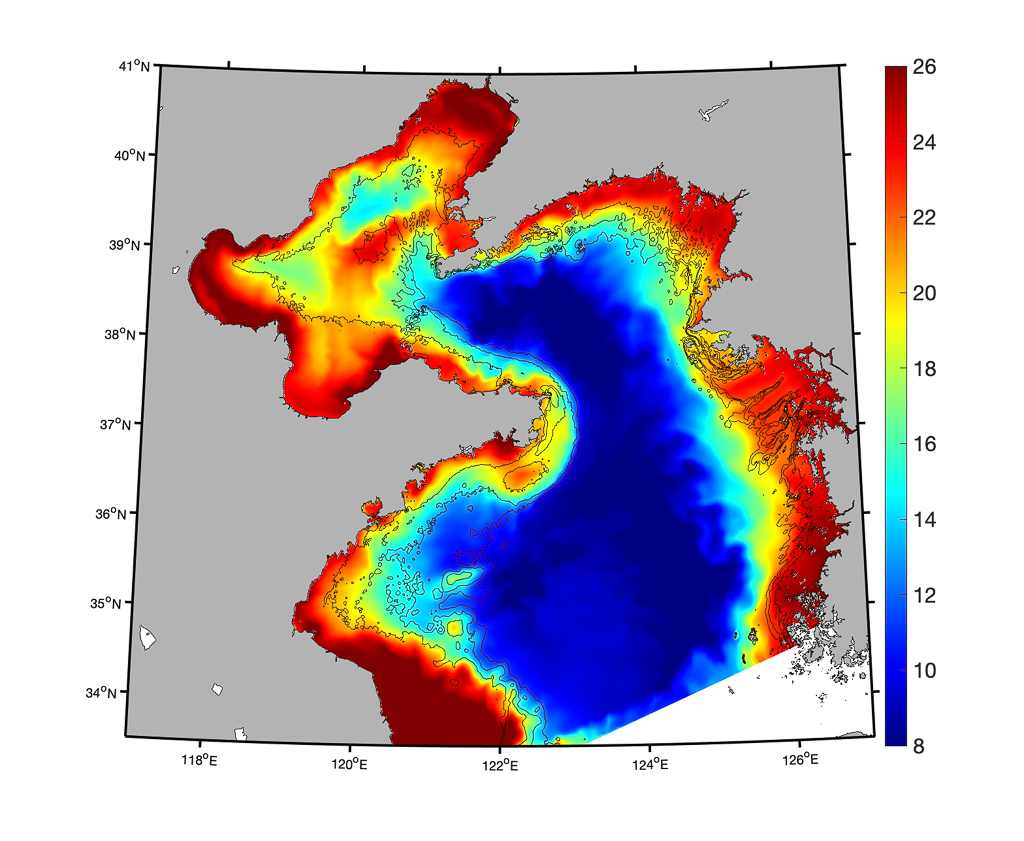Successful transfer of an ocean model to China

The Sanggou Bay in China with thousands of buoyancy blowers holding in place the equipment for growing shells and kelps. The Norwegian coastal current model is used here to provide calculations of food availability and growth in shellfish production.
Photo: Institute of Marine ResearchPublished: 07.09.2021 Updated: 14.09.2021
"The model results correspond well to available observations of current and temperature. They show how scallop farming areas can be exposed to large temperature fluctuations," says Lars Asplin, who leads the collaboration on current modelling.
The model, which is based on the Institute of Marine Research's own NorKyst800 model, has been used to identify which areas in the northern Yellow Sea may be exposed to large temperature fluctuations. The Yellow Sea is particularly susceptible to large variations in temperature, and this can have a potentially detrimental effect on scallops grown on the seabed.
The Institute of Marine Research cooperates with the Yellow Sea Fisheries Research Institute in Qingdao through the project "Environment and Aquaculture Governance". This collaboration and experience from Chinese aquaculture also give the IMR researchers important information back.

Monitoring the seabed in the Sanggou Bay
The model also provides results used in calculations of food availability and growth conditions for aquaculture production in the Sanggou Bay, one of the most important areas of aquaculture in China.
"In the collaboration, ecosystem models are now also being developed that will provide even better planning of sustainable production," says Asplin.
In the Sanggou Bay, we have also looked at changes in how shellfish and kelp cultivation have affected the bottom environment.
Here we have tested a system from management of fish farming in Norway that monitors the impact on the seabed, called Monitoring, Ongrowing fish farms, Modelling (MOM).
"A study shows that even in this bay that has perhaps the densest shellfish and kelp production in the world, a good state has been maintained in the bottom environment," Asplin says.
Changing Chinese aquaculture
Both Norway and China are major players in global aquaculture. China has long traditions and the largest production of kelp, shellfish and other species.
Over the past decade, aquaculture in China has changed. Due to increased concern on seafood safety and greater competition for space in the coastal zone, they have had a reduction in production growth.
"Chinese aquaculture is changing. From being governed to maximize growth in production, aquaculture is now affected by other factors, such as consumers with increasing concern on safe seafood and sustainable production," says IMR-researcher Øivind Strand.
There is greater competition for space in the coastal zone from other users like tourism, and an increased focus on habitat restoration and protection of coastal areas. Higher wages for Chinese workers also increase the need for technology development and forms of production that require knowledge of interactions with the environment.
Strengthens cooperation on food safety
The cooperation between the two institutes dates to the beginning of the 1980s. Now, cooperation on seafood safety is also being strengthened. Focus will be on bacteria and viruses, antibiotic resistance, plastic in the sea, heavy metals and medicines in aquaculture.
"The people I talk to are more concerned with seafood safety, and this facilitates good cooperation and exchange of knowledge, students and scientific personnel," says researcher Bjørn Tore Lunestad, who is responsible for the seafood part of the China cooperation.
Norway have unique knowledge of medicines
"We have a lot to learn from China in many areas, they have a lot of knowledge about antibiotic resistance that is also useful for Norway. This is a collaboration that goes both ways," says Lunestad.
At the same time, he explains that few countries have the system and knowledge to monitor medicines in seafood that Norway have.
"Everything from registration of drug use, to the methodology used and control of residual concentrations are things we have a good system and expertise in," says Lunestad.
References:
Asplin, L., Lin, F., Budgell, W. P., & Strand, Ø. (2021). Rapid water temperature variations at the northern shelf of the Yellow Sea. Aquaculture Environment Interactions, 13, 111-119.
The article: Inter Research » AEI » v13 » p111-119 (int-res.com)
